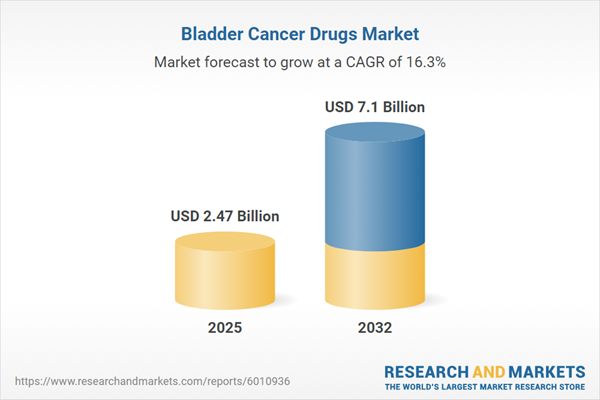Speak directly to the analyst to clarify any post sales queries you may have.
Senior executives seeking reliable growth in the bladder cancer drugs market must respond to shifting regulatory environments and rapid innovation cycles. Sustainable success depends on agile strategies, as therapeutic advances and evolving payer demands redefine competitive dynamics for pharmaceutical leaders.
Market Snapshot: Bladder Cancer Drugs Market Size and Growth
The bladder cancer drugs market is on course for strong expansion, supported by a resilient compound annual growth rate (CAGR). This momentum is driven by the rapid integration of next-generation immuno-oncology therapies and novel targeted approaches, which challenge traditional treatment paradigms and improve alignment with evolving patient needs. Real-world data analytics is growing in strategic importance, facilitating smarter lifecycle management and more timely regulatory submissions. Advances in the supply chain, combined with greater regulatory flexibility, are enabling drug manufacturers to capture new opportunities, even as rising competition and regional reimbursement complexities intensify the need for responsive go-to-market and patient retention strategies.
Scope & Segmentation in the Bladder Cancer Drugs Market
- Cancer Types: Encompasses therapy strategies for both muscle-invasive and non-muscle-invasive bladder cancer, each requiring distinct clinical solutions that shape patient treatment pathways.
- Treatment Types: Includes chemotherapy, immune checkpoint inhibitors, monoclonal antibodies, as well as newer options like FGFR and tyrosine kinase inhibitors—all influencing the development and adoption speed of therapies.
- Drug Types: Covers a range from established therapies to pipeline drugs such as atezolizumab, avelumab, and erdafitinib, each presenting varying effects across patient subgroups and practice settings.
- Administration Routes: Reviews the impact of intravenous, intravesical, and oral delivery on patient compliance, clinical workflow efficiency, and convenience for both providers and patients.
- Distribution Channels: Analyzes the roles of hospital, retail, and specialty pharmacy channels, considering patient access, reimbursement trends, and supply chain performance regionally.
- Regions: Examines market conditions across the US, Brazil, Canada, Europe, Middle East, Africa (with the UK, Germany, Nigeria, Egypt as key examples), and Asia-Pacific, notably China, India, and Japan. Regional differences in patient demographics, readiness for technology adoption, and regulatory environments present unique challenges.
- Key Companies: Evaluates major firms including Merck & Co., F. Hoffmann-La Roche, Pfizer, Merck KGaA, AstraZeneca, Bristol-Myers Squibb, Astellas Pharma, Johnson & Johnson, and Seagen Inc., focusing on their evolving product portfolios and approaches to regional expansion.
Key Takeaways for Strategic Decision-Makers in the Bladder Cancer Drugs Market
- Rapid developments in immuno-oncology are diversifying therapy portfolios, enabling companies to align with shifting clinical needs and maintain robust research pipelines.
- Advances in digital pathology and molecular diagnostics enhance patient stratification, supporting more tailored treatment solutions and compliance with international care standards.
- Cross-border clinical collaboration accelerates new therapy development and supports adaptation to varying regulatory frameworks and delivery models.
- Strategic partnerships and adaptive sourcing strategies reinforce market agility, helping organizations meet compliance and regulatory expectations across increasingly segmented international environments.
- Leveraging real-world evidence and sophisticated analytics improves understanding of payer value, supporting sustainable pricing decisions and enhancing broad patient access.
Tariff Impact: Navigating the 2025 US Measures
Upcoming US tariff regulations scheduled for 2025 require manufacturers and supply chain leaders in the bladder cancer drugs market to take proactive steps. Executives are optimizing manufacturing and distribution systems to enable better cost management and ensure steady product supply. Adoption of risk-sharing procurement models supports reliable therapy delivery and cost control, while collaboration with regional contract manufacturers helps mitigate potential disruptions. Enhanced oversight of operations and coordinated decisions across procurement, compliance, and logistics remain crucial to sustaining market readiness as compliance requirements evolve.
Methodology & Data Sources
This report’s findings reflect a rigorous methodology, integrating direct industry stakeholder engagement, in-depth reviews of clinical trials, regulatory benchmarking, and targeted surveys. Consistent triangulation of these data sources ensures actionable, reliable insights for senior leaders.
Why This Report Matters
- Gives clarity for executives to prioritize investments and portfolio planning using clear segmentation by cancer subtype, therapy type, adoption of innovative technologies, and key geographic markets.
- Equips teams with intelligence to refine product strategies, optimize market entry, and proactively address evolving reimbursement and pricing dynamics.
- Highlights emerging risks and access challenges, offering guidance for informed regional expansion and sustainable competitive positioning.
Conclusion
This report provides a robust strategic framework, helping senior decision-makers manage risk, stimulate innovation, and guide resilient market expansion as the bladder cancer drugs sector advances.
Additional Product Information:
- Purchase of this report includes 1 year online access with quarterly updates.
- This report can be updated on request. Please contact our Customer Experience team using the Ask a Question widget on our website.
Table of Contents
3. Executive Summary
4. Market Overview
7. Cumulative Impact of Artificial Intelligence 2025
Companies Mentioned
The companies profiled in this Bladder Cancer Drugs market report include:- Merck & Co., Inc.
- F. Hoffmann-La Roche Ltd
- Pfizer Inc.
- Merck KGaA
- AstraZeneca PLC
- Bristol-Myers Squibb Company
- Astellas Pharma Inc.
- Johnson & Johnson
- Seagen Inc.
Table Information
| Report Attribute | Details |
|---|---|
| No. of Pages | 198 |
| Published | October 2025 |
| Forecast Period | 2025 - 2032 |
| Estimated Market Value ( USD | $ 2.47 Billion |
| Forecasted Market Value ( USD | $ 7.1 Billion |
| Compound Annual Growth Rate | 16.2% |
| Regions Covered | Global |
| No. of Companies Mentioned | 10 |









